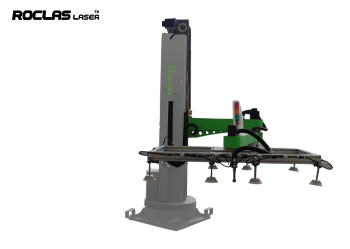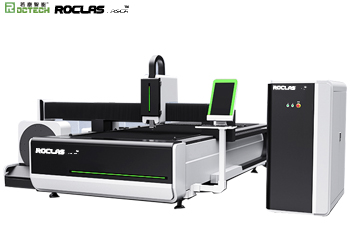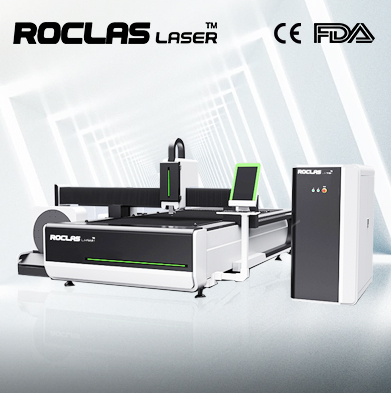Bevezetés
A lézergépek különböző iparágakat forradalmasítottak azáltal, hogy pontosságot, hatékonyságot és sokoldalúságot kínálnak az anyagfeldolgozásban. A vágástól és gravírozástól kezdve a hegesztésig és jelölésig a lézergépek nélkülözhetetlen eszközökké váltak a gyártásban, az egészségügyben, sőt a művészetben is. Ez az átfogó útmutató bemutatja a lézergépek különböző típusait, alkalmazásait és a dinamikus területet kialakító jövőbeli trendeket.
Lézergépek típusai

1. CO2 lézeres gépek

A CO2 lézeres gépek a leggyakrabban használt típusok közé tartoznak, különösen gravírozási és vágási alkalmazásokban. Gázkeveréket használnak, elsősorban szén-dioxidot, hogy lézersugarat állítsanak elő. Ezek a gépek rendkívül hatékonyak nemfémes anyagokhoz, mint például fa, akril, üveg és textíliák. Sokoldalúságuk és viszonylag alacsony költségük teszi őket népszerűvé a jelzéstől a divatig terjedő iparágakban.

2. Fiber Laser Machines
A szálas lézergépek nagy hatékonyságukról és pontosságukról ismertek, különösen a fémfeldolgozásban. Szilárd állapotú lézerforrást használnak, ahol az aktív közeg egy olyan optikai szál, amelyet ritkaföldi elemekkel, mint az erbium vagy itterbium adagolnak. A szálas lézerek ideálisak fémek, például acél, alumínium és réz vágására, hegesztésére és jelölésére. Kompakt kialakításuk és alacsony karbantartási követelményeik miatt kedvencek lettek az autóiparban és a repülőgépiparban.
3. Nd: YAG és Nd: YVO4 lézeres gépek
A neodímium-adagolt ittrium alumínium gránát (Nd: YAG) és neodímium-adagolt ittrium orthovanadát (Nd: YVO4) lézerek szilárdtest lézerek, amelyeket különböző alkalmazásokban használnak, beleértve az orvosi eljárásokat, az anyagfeldolgozást és a tudományos kutatásokat. Ezek a lézerek különösen hatékonyak nagy teljesítményű alkalmazásokhoz, és használhatók fémek és kerámia vágására, hegesztésére és fúrására.
4. Dióda lézeres gépek
Diode lasers are semiconductor-based lasers that are compact, energy-efficient, and cost-effective. They are commonly used in applications such as barcode scanning, laser printing, and medical treatments. Diode lasers are also finding increasing use in material processing, particularly in low-power cutting and engraving tasks.
Applications of Laser Machines
1. Manufacturing and Industrial Applications
Laser machines have become integral to modern manufacturing processes. They are used for cutting, welding, engraving, and marking a wide range of materials. In the automotive industry, laser welding ensures strong and precise joints, while laser cutting is used for intricate metal parts. In electronics, lasers are employed for micro-machining and PCB (Printed Circuit Board) manufacturing.
2. Medical and Healthcare Applications
The medical field has embraced laser technology for its precision and minimally invasive capabilities. Lasers are used in surgeries, dermatology, ophthalmology, and dentistry. For instance, laser eye surgery (LASIK) has become a popular method for correcting vision, while laser ablation is used for removing tumors and treating various skin conditions.
3. Art and Design
Artists and designers have found laser machines to be invaluable tools for creating intricate and detailed works. Laser engraving and cutting allow for precise and repeatable designs on materials such as wood, acrylic, and leather. This technology has opened up new possibilities in custom jewelry, architectural models, and personalized gifts.
4. Aerospace and Defense
The aerospace and defense industries demand high precision and reliability, making laser machines a natural fit. Lasers are used for cutting and welding complex components, as well as for marking and engraving parts for traceability. The ability to work with high-strength materials like titanium and composites is particularly important in these sectors.
5. Research and Development
Laser machines play a crucial role in scientific research and development. They are used in spectroscopy, microscopy, and material analysis. Lasers are also employed in experimental setups for studying fundamental physical phenomena, such as quantum mechanics and plasma physics.
Future Trends in Laser Technology
1. Increased Automation and Integration
The future of laser machines lies in increased automation and integration with other manufacturing processes. Smart factories are adopting laser machines that can communicate with other equipment, enabling seamless production lines. Advanced software and AI-driven systems are being developed to optimize laser parameters in real-time, improving efficiency and reducing waste.
2. Miniaturization and Portability
As technology advances, laser machines are becoming more compact and portable. This trend is particularly evident in medical and field applications, where portable laser devices can be used for on-site treatments and repairs. Miniaturized lasers are also being integrated into consumer electronics, such as smartphones and wearable devices.
3. Enhanced Precision and Power
Ongoing research is focused on developing lasers with higher precision and power. Ultrafast lasers, which operate in the femtosecond and attosecond range, are enabling new applications in micromachining and medical procedures. High-power lasers are being developed for industrial applications, such as thick metal cutting and deep welding.
4. Sustainable and Eco-Friendly Lasers
Sustainability is becoming a key consideration in the development of laser machines. Efforts are being made to reduce the energy consumption and environmental impact of lasers. This includes the use of renewable energy sources, recyclable materials, and eco-friendly cooling systems. Additionally, lasers are being used in environmental applications, such as pollution monitoring and waste management.
5. Expansion into New Materials and Applications
The versatility of laser machines is driving their expansion into new materials and applications. For example, lasers are being used to process advanced materials like graphene and carbon nanotubes, which have unique properties and potential applications in electronics and energy storage. Lasers are also being explored for use in 3D printing, where they can enable the precise deposition of materials for complex structures.
Conclusion
Laser machines have come a long way since their inception, evolving into powerful and versatile tools that are transforming industries and enabling new possibilities. From CO2 and fiber lasers to diode and solid-state lasers, each type offers unique advantages for specific applications. As technology continues to advance, we can expect to see even greater precision, efficiency, and sustainability in laser machines. Whether in manufacturing, healthcare, art, or research, lasers are poised to play an increasingly important role in shaping the future.
Függetlenül attól, hogy általános tanácsra vagy konkrét támogatásra van szüksége, örömmel segítünk Önnek.